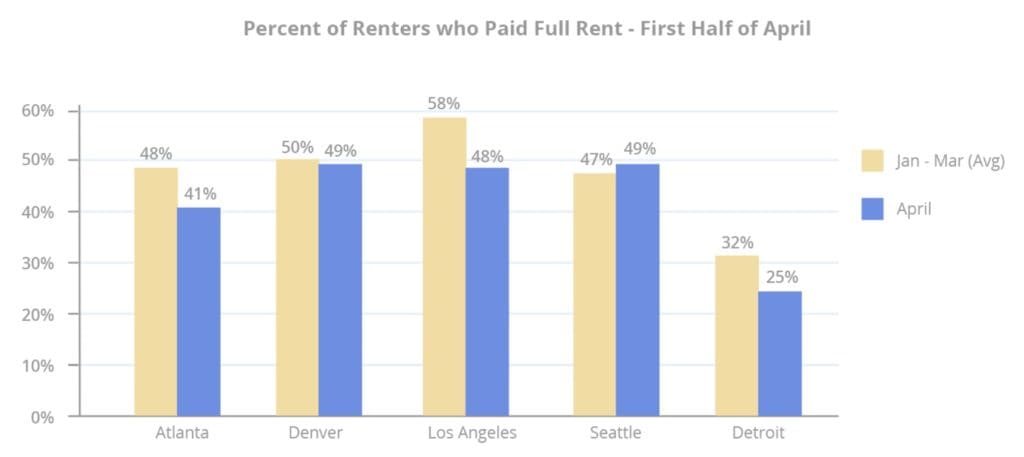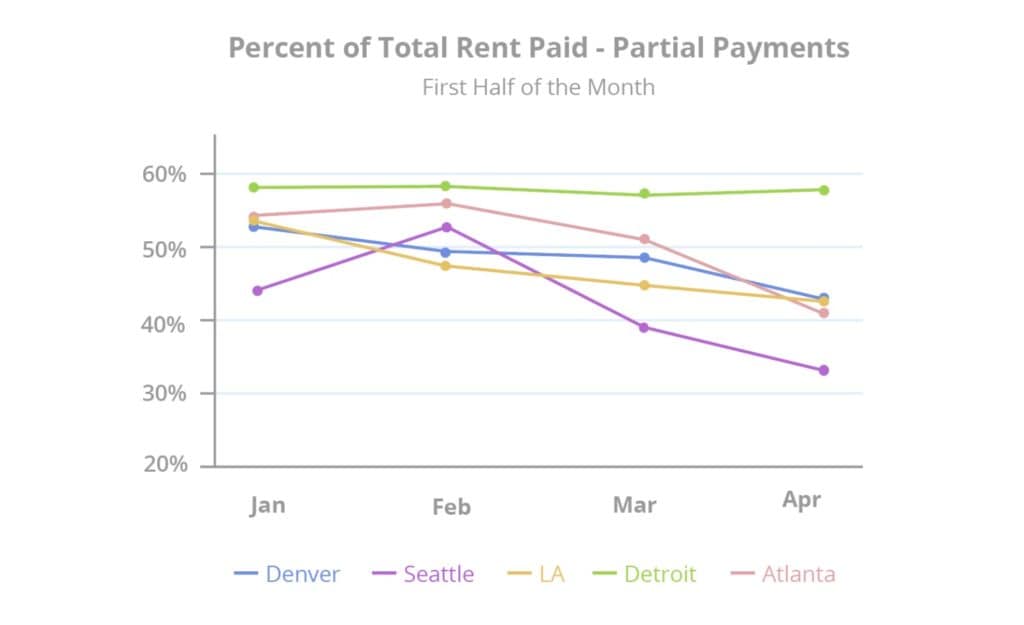Mid-Month Update: April Rent Payments Trickling In Below Pace – But Better Than Expected
Important statistical note: Despite the measured payment decline based on the sample set, the variance is within normal statistical range. In other words, the decline is not significant enough to attribute specifically to COVID-19 versus normal fluctuations expected across the data set. Please reference full methodology in footnote.
Now that we’re halfway through the month, we’ve decided to take a mid-month look at rent payment behavior from April 1-15 to evaluate any shifts since publishing our Rent Payment Report. Nationwide, we see a 7% decrease in total rent collected in April compared to the average month, a trend which has continued as rent payments trickle in. Drilling down, we see a growing movement towards partial payments in major metros like Los Angeles, Seattle, and Atlanta.
Mid-April Rent Payments Continue Downward Trend
After a brief spike in payments on the first of the month, full rent payments have continued tracking roughly below average in April. Interestingly, on April 6-8th, the days immediately following the traditional grace period, the percent of renters who made full rent payments stayed mostly the same — if not marginally higher — than average. This minor boost could have been due to grace period extensions, or because April 5 fell on a Sunday and leasing offices were unable to process checks until April 6.
As the month trailed on, however, rent payments fell again. Despite federal stimulus checks being sent to qualified Americans over the past several days, April full rent payments are holding below average, and this trend appears to be continuing on a slight downward trajectory moving into May.
Mid-April Rent Payments Continue Downturn In Most Metro Areas
When we look at locational trends, we see that the drop in full rent payments in Los Angeles remains significant, as found in our earlier analysis. Atlanta and Detroit still show dips in April full rent payments as well, while Seattle actually saw a slight increase—but as we’ll dive into below, the amount paid by partial rent payers has dropped significantly in the Seattle area.
The number of renters who made some form of rent payment dropped in both Los Angeles, Atlanta, and Detroit. Denver held steady, while Seattle showed a slight increase in the percent of renters making April rent payments, as noted above.
Cities like Seattle and Los Angeles Show Movement Toward Payment Plans
However, as we found in our early April reporting, the total percentage of owed rent paid by partial payers declined dramatically in Seattle. So, although Seattle renters made more overall rent payments in April, the portion of total rent paid by partial rent payers dwindled substantially. This could be due in part to operators working in advance to offer payment plans in Seattle, which was hit early on by the crisis. This rent payment gap effect also increased in Atlanta over the last several days.
It’s likely that the growing movement towards partial payments is due to operators proactively adopting payment plans, especially in metro areas like Atlanta, Los Angeles, and Seattle.
City Ordinances Could Have Impact On Partial Rent Payments
The steep decline in the amount of owed rent paid in Atlanta could be related to a new Atlanta Housing ordinance introduced on April 7, which offers rent reductions for residents financially impacted by COVID-19. While the rent relief effort is designed to pay rent directly to property owners or management companies, approved requests can take as many as 15 days to be paid out by Atlanta Housing authorities—meaning there could be a lag between processing applications, approving renter requests, and submitting direct payments to owners. Los Angeles passed a similar ordinance on April 14, which may explain the move towards partial payments seen in that metro area as well.
As we near May, we will continue to track rent payment behavior and publish our findings to help operators understand important trends during the COVID-19 crisis. Stay tuned!
Methodology
Rent payment data is actual transactional data sourced from direct integrations with property management systems in the multifamily industry.
Analysis includes a 96,268 unit sample from 1,029,428 live units under management by LeaseLock clients. Data is nationwide, representing over half of the NMHC Top 10 property managers in the country and all asset classes (A, B and C). Asset class composition: class A (36%), class B (55%) class C (9%).
All data has been anonymized to remove personally identifiable information for renters and property managers.








